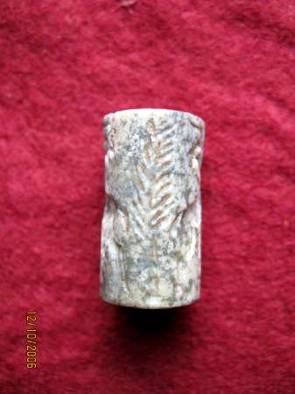
|
|

|
YOU ARE HERE:>>Collectors' Resources>>Essentials>>Researching your artifacts page 3
31st March 07
Olaf acquired this interesting cylinder seal from me:

Hi Bron,
I discussed the seal with Dr. Sylvia Winkelmann again. She comes to the conclusion that the seal ist NOT Akkkadian, it is clearly from early dynastic period (EDII-III 2700-2400 B.C.).
Contest friezes occur in both cultures in ED it's the main theme on cylinder seals, beside banquet scenes which seem exclusively to appear on seals used by women (Ur royal graves, Queen Puhabi) It is easy to distinguish the two groups (see photo)
On ED seals, the animals are often crossing each other (Please compare the attacking lions on D) and E), on Akkadian seals they don't. The figures stand alone, very often a bull chimera appears with the head turned towards the viewer. The figures are often positioned in a symmetric order.
The symmetry of this seal probably led Prof. Lambert to the assumption, that it is Akkadian.
Of course not every ED or Akkadian seal with contest friezes fits perfectly to the groups and there is a transition phase (EDIIIb), but you can easily distinguish, what is TYPICAL ED or TYPICAL Akkadian. The ED seals B) and C) are from stratified layers.B) comes from Khafadje in the Diyala region and C) comes from Tell Asmar.
Hi Bron,
I compared the seal to several pieces from ED II-III. Attached you find a pic of a seal that is attributed to the "Fara-Style" from the Sumerian town Shuruppak. The similarity of the details is striking, isn't it ?
Hi Bron,
the seal is certainly NOT typical Fara-Style. On Fara seals the figures are more gracile and abstract and the bull-man often appears. (see attachement, some more examples from the Near Eastern Museum in Berlin) but it seem to be influenced by this style and is probably from the same time around 2500 B.C. I think it will be impossible to find out, where exactly it was made but certainly it is not a provincial one. I think it must be of one of the cities in Sumer (Ur, Kisch, Lagasch, Fara,....)
Cheers
Olaf
Hi Bron,
I did some further research on our cylinder seal. J.G. Volk, Editor of the Anavian Collection mentiones similar seals in Susa, Kish and Ur. I haven't seen the seal from Ur yet, but I found the seals from Kish and Susa. (see photo) They are cut in a crude style. Our seal is more elaborate, it looks like a model of this group.
This specific contest scene is very scarce. Neither in the corpus of seals in American collections nor in German museum collections I found a similar seal. Maybe Phil can find out more ?
However, the excellent style leads me again to the conclusion, that is must be from the centre of Sumerian culture. It is certainly not a provincial one.
Very interesting!
To be continued.
From Phil
31st March
Olaf,
This piece is a classical early ED III following examples that certainly could also hail from Ur... I took a peep in the dig records from LeGrain, U. Penn. 1951. This type matches to several examples found then, ref. pl. II, 140, 142...There are several other references I have here for ED III/Sargonic period pieces. Again, as above, the trick is pretty simple: crossing animals - EDIII animals standing seperately - Sargonic/post Sargonic...
Have you considered looking into geological surveys in and around Ur to see if you can find a match for the stone? It might provide some interesting results and you might be able to pinpoint the piece to an original area that way...
From Phil
13th April 07
It seems that you have access to Moortgat... if so, reference seal 112. Again, it comes from Ur, noted here from the time of Ur I (which complements Legrain 1951 well I think.) I believe Legrain's dig was later, by several years. BTW, he notes that 140/142 were found in a "Sargonic" level, but that doesn't suggest to me that they come from the period, just that these 2 particular pieces noted in Legrain were found from that time.
Your piece seems to really have the "eyes" from ED IIIa, which is a pretty strong indicator. That changes beginning in ED IIIb (ability to make deeper intaglios as perhaps a reason for the change in style?).
It just goes to show you though that when it comes to seals, for every rule, there are several exceptions!


Home | About This Site | Privacy Statement | Gallery | Testimonials | Guarantees
About Collectors' Resources pages | What's New
Search | Site Map | Contact Us